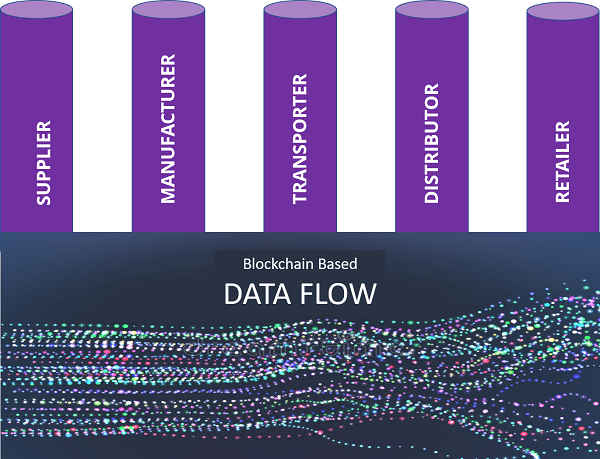Supply Chain is invariably one of the most prominent backstage activities that run our daily lives. In every moment of our daily lives, whatever articles we use, the food that we eat, the car we travel in, the bed in which we sleep and almost everything around us, has gone through its own chain of supply from the very origin to reach us, the consumers.
A supply chain consists of a network of interconnected businesses, right from procurement of raw materials to the delivered goods, in the hands of the consumers. This also entails the suppliers of raw materials, manufacturers, transporters, warehouses, retailers etc throughout the chain. To maintain a healthy and effective supply chain is a challenge, considering the myriad factors affecting it and the complex topology they present. As the hops in the supply chain keep on getting more and more dispersed, it becomes increasingly difficult to track and trace supplied goods.
Supply chain management can be broadly classified into the following components:
Any break in the chain will end up in disruption of the system with a domino-like effect.
Collaboration, visibility, and agility are the key mantras for managing the supply chain effectively. And to achieve these objectives, supply chain businesses need to come on a common platform and share information with each other. Strategic partnerships help boost the performance of the supply chain, thus enabling a win-win situation for all the participants.
“Blockchain is a digital, decentralized and distributed ledger in which transactions are logged and added in chronological order with the goal of creating permanent and tamper-proof records”
Blockchain, the technology that drives Bitcoin and other so-called cryptocurrencies, has several far-reaching applications beyond just virtual money. Blockchain can manage any form of exchange, tracking, and agreements. Being decentralized, no centralized authority is needed for its functioning. This makes it quite suitable for a multi-party ecosystem, where trust between the parties is inherently garnered by the technology itself. With the use of strong cryptography, the data in the blockchain remains secure and immutable.
As noted earlier, supply chain partnerships provide firms with opportunities to improve their conduct of business, and as such paves the way for an extended, globally connected supply chain, with focus on sharing the information. Platforms built on blockchain can effectively cater to the needs of such a globally connected supply chain. Being decentralized, trustful and auditable, blockchain clearly lends itself to such a global supply chain platform, involving multiple partners.
Blockchain helps to bridge the information gap between the participants by providing a unified view of the underlying data, with end-to-end visibility. This enables the participants to harness the data in their own ways, thus increasing the overall operating efficiency of the system.

The amalgamation of blockchain with supply chain creates a win-win situation for all the participants. Better visibility, accurate and reliable data and a boost in trust among all participants are some of the key benefits of adding blockchain to the supply chain network.
In a traditional supply chain, the data is fragmented into various “data silos”. For example, in a typical food supply chain, complying with the “one step forward, one step back” EU regulation, businesses can identify the businesses to which their products have been supplied and trace food chain inputs back to the immediate supplier. Due to the high information asymmetry, end-to-end traceability of the products is time taking and cumbersome.
Figure 2: Traditional Supply Chain
Supply chain solutions built on blockchain allow for tracking, tracing, provenance, faster trade settlements, better inventory management, production planning, fine-tuning transportation routes, etc., thus helping businesses to be more agile and profitable. Consider the ‘Bullwhip effect’, a typical phenomenon because of which even though the customer demands do not vary much, back order and inventory levels fluctuate considerably across the supply chain. To highlight the issue, consider the second stage in the chain, the wholesaler. To forecast the retailers’ demand, due to lack of direct access to customer demand, he must rely on the orders placed by the retailer.
Fig 4: The Supply Chain Flow
A little variance in orders placed by the retailer may result in highly significant variability, as we go higher up in the ladder. This happens because at each stage, considering the lead times, each of the participants may be forced to carry more safety stock and thus inflate the orders upwards, leading to high variance. Had it been a blockchain platform, with an end to end visibility of data, this would not have been the case. Many other pain points of the supply chain industry can be addressed just by having end-to-end visibility of information. In this case, tracking, tracing and auditing becomes much easier with a huge decrease in the overall time taken for these activities.
Looking at the promises the blockchain holds for the supply chain market, blockchain in supply chain is set to an unprecedented growth and is expected to grow to a USD 3,314.6 million market by 2023, according to the report “Blockchain Supply Chain Market by Application (Payment & Settlement, Counterfeit Detection, Smart Contracts, Risk & Compliance Management, and Product Traceability), Provider, Vertical, and Region – Global Forecast to 2023″.